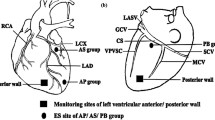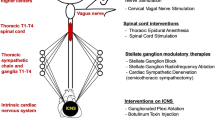Abstract
Background
This study tested the hypothesis that median nerve stimulation (MNS) prevents ventricular arrhythmias (VAs) induced by dorsomedial hypothalamus stimulation (DMHS) and investigated the electrophysiological mechanisms underlying the anti-arrhythmic effects of MNS by recording left stellate ganglion activity (LSGA).
Methods
Eighteen rabbits were anesthetized, the median nerve was anchored by stimulating electrodes, and a bipolar electrode was implanted into the LSG to record nerve activity. The DMH was stimulated to induce arrhythmia. All animals underwent six repetitions of DMHS (30 s). The 18 rabbits were divided into the following 3 groups: a control group, which underwent only DMHS (n = 6); an MNS group, which underwent MNS during both the third and fourth DMHS repetitions (n = 6); and an LSGA-recording group, for which LSGA was recorded at baseline, immediately following DMHS and again immediately following MNS and DMHS (n = 6).
Results
Repeated DMHS-induced multiple VAs, in the rabbits. Compared with the DMHS-only group, the concurrent administration of MNS during DMHS significantly reduced the incidence of VAs (7 ± 3 and 9 ± 2 beats for the third and fourth DMHS + MNS repetitions vs. 29 ± 8 and 27 ± 9 beats for the first two DMHS repetitions, p < 0.05). The total duration of the abnormal discharges of the LSG (ADLSG) following MNS and DMHS was significantly reduced compared with that of the DMHS-only group (40 ± 18 vs. 14 ± 6 s, p < 0.05).
Conclusion
MNS reduced VAs induced by DMHS, which is thought to be mediated through suppressing of ADLSG.
New and noteworthy
Median nerve electrical stimulation prevented ventricular arrhythmias induced by DMHS through the mechanism of suppressing abnormal discharges of left stellate ganglion.





Similar content being viewed by others
References
Stecker EC, Reinier K, Marijon E, Narayanan K, Teodorescu C, Uy-Evanado A, et al. Public health burden of sudden cardiac death in the United States. [Multicenter Study Research Support, N.I.H., Extramural]. Circ Arrhythm Electrophysiol. 2014;7(2):212–7.
Lampert R, Jain D, Burg MM, Batsford WP, McPherson CA. Destabilizing effects of mental stress on ventricular arrhythmias in patients with implantable cardioverter-defibrillators. Circulation. 2000;101(2):158–64.
Leor J, Poole WK, Kloner RA. Sudden cardiac death triggered by an earthquake. N Engl J Med. 1996;334(7):413–9.
DiMicco JA, Samuels BC, Zaretskaia MV, Zaretsky DV. The dorsomedial hypothalamus and the response to stress: part renaissance, part revolution. [Research Support, U.S. Gov’t, P.H.S. Review]. Pharmacol Biochem Behav. 2002;71(3):469–80.
Fontes MA, Xavier CH, Marins FR, Limborco-Filho M, Vaz GC, Muller-Ribeiro FC, et al. Emotional stress and sympathetic activity: contribution of dorsomedial hypothalamus to cardiac arrhythmias. Brain Res. 2014;1554:49–58.
Fontes MA, Xavier CH, de Menezes RC, Dimicco JA. The dorsomedial hypothalamus and the central pathways involved in the cardiovascular response to emotional stress. Neuroscience. 2011;184:64–74.
Zaretskaia MV, Zaretsky DV, Shekhar A, DiMicco JA. Chemical stimulation of the dorsomedial hypothalamus evokes non-shivering thermogenesis in anesthetized rats. [Research Support, U.S. Gov’t, P.H.S.]. Brain Res. 2002;928(1-2):113–25.
Andersson S. The functional background in acupuncture effects. Scand J Rehabil Med Suppl. 1993;29:31–60.
Li P, Pitsillides KF, Rendig SV, Pan HL, Longhurst JC. Reversal of reflex-induced myocardial ischemia by median nerve stimulation: a feline model of electroacupuncture. [Research Support, Non-U.S. Gov’t Research Support, U.S. Gov’t, P.H.S.]. Circulation. 1998;97(12):1186–94.
Zhou W, Ko Y, Benharash P, Yamakawa K, Patel S, Ajijola OA, et al. Cardioprotection of electroacupuncture against myocardial ischemia-reperfusion injury by modulation of cardiac norepinephrine release. Am J Physiol Heart Circ Physiol. 2012;302(9):H1818–1825.
Zhou X, Wolf PD, Smith WM, Blanchard SM, Ideker RE. Effects of peroneal nerve stimulation on hypothalamic stimulation-induced ventricular arrhythmias in rabbits. [Comparative Study Research Support, Non-U.S. Gov’t Research Support, U.S. Gov’t, Non-P.H.S. Research Support, U.S. Gov’t, P.H.S.]. Am J Physiol. 1994;267(5 Pt 2):H2032–2041.
Sawyer CH, Everett JW, Green JD. The rabbit diencephalon in stereotaxic coordinates. J Comp Neurol. 1954;101(3):801–24.
Curtis MJ, Walker MJ. Quantification of arrhythmias using scoring systems: an examination of seven scores in an in vivo model of regional myocardial ischaemia. Cardiovasc Res. 1988;22(9):656–65.
Sidi A, Gehrig RT, Rush W, Davis RF. Left-sided stellate ganglion ablation or “rate-controlled” vagal nerve stimulation decreases regional myocardial metabolic impairment during acute ischemia in dogs. [Comparative Study Research Support, Non-U.S. Gov’t]. J Cardiothorac Vasc Anesth. 1995;9(1):50–8.
Lujan HL, Kramer VJ, DiCarlo SE. Electroacupuncture decreases the susceptibility to ventricular tachycardia in conscious rats by reducing cardiac metabolic demand. [Research Support, N.I.H., Extramural]. Am J Physiol Heart Circ Physiol. 2007;292(5):H2550–2555.
Zhang H, Liu L, Huang G, Zhou L, Wu W, Zhang T, et al. Protective effect of electroacupuncture at the Neiguan point in a rabbit model of myocardial ischemia-reperfusion injury. Can J Cardiol. 2009;25(6):359–63.
Ogawa M, Zhou S, Tan AY, Song J, Gholmieh G, Fishbein MC, et al. Left stellate ganglion and vagal nerve activity and cardiac arrhythmias in ambulatory dogs with pacing-induced congestive heart failure. [Comparative Study Research Support, N.I.H., Extramural Research Support, Non-U.S. Gov’t]. J Am Coll Cardiol. 2007;50(4):335–43.
Shen MJ, Shinohara T, Park HW, Frick K, Ice DS, Choi EK, et al. Continuous low-level vagus nerve stimulation reduces stellate ganglion nerve activity and paroxysmal atrial tachyarrhythmias in ambulatory canines. [Research Support, N.I.H., Extramural Research Support, Non-U.S. Gov’t]. Circulation. 2011;123(20):2204–12.
Zhou X, Vance FLT, Sims AL, Sreenan CM, Ideker RE. Prevention of high incidence of neurally mediated ventricular arrhythmias by afferent nerve stimulation in dogs. [Research Support, Non-U.S. Gov’t Research Support, U.S. Gov’t, P.H.S.]. Circulation. 2000;101(7):819–24.
Xavier CH, Beig MI, Ianzer D, Fontes MA, Nalivaiko E. Asymmetry in the control of cardiac performance by dorsomedial hypothalamus. [Research Support, Non-U.S. Gov’t]. Am J Physiol Regul Integr Comp Physiol. 2013;304(8):R664–674.
Xavier CH, Nalivaiko E, Beig MI, Menezes GB, Cara DC, Campagnole-Santos MJ, et al. Functional asymmetry in the descending cardiovascular pathways from dorsomedial hypothalamic nucleus. Neuroscience. 2009;164(3):1360–8.
Acknowledgments
This work was supported by the National Natural Science Foundation of China (Grant 81270243 to Shu Zhang, 81300139 to Jingli Gu, 81441018 to Min Tang, and 1171088 to Ji-Min Cao) and Peking Union Medical College Innovation Fund (10023-1002-1008 to Shuang Zhao).
Author information
Authors and Affiliations
Corresponding authors
Ethics declarations
Conflict of interest
The authors declare that they have no conflict of interest.
Additional information
Shuang Zhao and Min Tang contributed equally to this work.
Rights and permissions
About this article
Cite this article
Zhao, S., Tang, M., Yuan, K. et al. Median nerve stimulation reduces ventricular arrhythmias induced by dorsomedial hypothalamic stimulation. J Interv Card Electrophysiol 47, 275–283 (2016). https://doi.org/10.1007/s10840-016-0150-5
Received:
Accepted:
Published:
Issue Date:
DOI: https://doi.org/10.1007/s10840-016-0150-5




